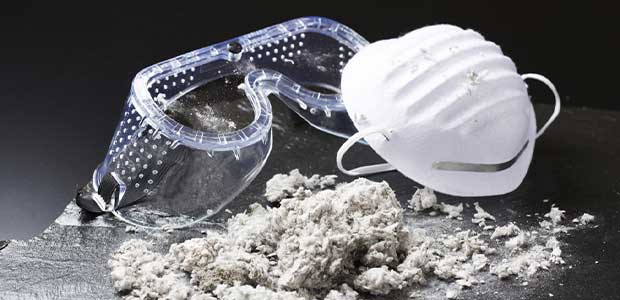
Monitor for Asbestos to Help Save Lives
Ensure your worksites are asbestos free.
- By Tim Turney
- May 01, 2022
Occupational asbestos exposure impacts more than a million Americans each year.1 Once hailed a “wonder material,” asbestos served a central role in American commercial product manufacturing and construction throughout the 20th century because of its electrical insulating and heat resistant properties. Today, it is recognized as a carcinogen and hazardous substance that takes2
Left alone, the material is not harmful, but once disturbed or disintegrating, it can release asbestos fibers that infiltrate and progressively damage the lungs. The damage can take decades to develop, often well into retirement and old age. Tragically, by the time lung diseases such as mesothelioma are diagnosed, it is often too late for effective treatment and proves fatal.
A Complete Asbestos Ban has yet to be passed in the U.S.
Despite a general ban by the United States Environmental Protection Agency (EPA), a complete asbestos ban has yet to be passed in the U.S. Asbestos can still be found in older homes, industrial properties and certain products. There are numerous regulations in place at state and federal levels to protect Americans from exposure. A partial ban on asbestos was passed in 1989, however, many of the regulations were overturned and it is still legal for some products to contain up to 1 percent of (chrysotile) asbestos.3
Whenever asbestos is known to be present, it is a legal requirement for licensed contractors to remove the hazardous material following strict regulations and guidance to limit the potential release of dangerous, airborne fibers. The guidance, depending on national practice, typically includes personal air sampling and/or static air sampling to ensure that there is no exposure during remediation work or during the cleaning and clearance processes at a removal site.
Asbestos monitoring has the power to save lives, but only when carried out correctly.
Following Best Practice
The asbestos clearance process tends to involve a preliminary check of the site condition and job completeness, a thorough visual inspection inside the enclosure or work area, air monitoring to gather samples for laboratory analysis and a final assessment of the post-enclosure or work area following dismantlement. Using remote methods to support sampling, such as Bluetooth and a mobile phone app, will help to protect personal exposure safety while gathering the necessary measurements. Licensed contractors may also take samples before work is undertaken to establish a background level measurement. Conducting a test before disturbing any construction materials could save thousands of dollars on decontamination and environmental cleaning fees and help to avoid exposure. Additionally, trained professionals may take samples during work on or near asbestos to confirm that there is no leakage from the enclosure.
Legal requirements will differ depending on the site, for example, OSHA sets specific regulations for several industries, including manufacturing, shipyards and construction. The Asbestos Hazard Emergency Response Act (AHERA), on the other hand, was created by the EPA to address asbestos found in schools and other learning facilities.
Maximizing Accuracy, Minimizing Risks
Discrepancies in sampling and analysis procedures, limitations in personal protective clothing and insufficient cleaning before a clearance pass can hinder accuracy and increase risks. The EPA requires that professionals performing asbestos repair and removal are thoroughly trained and accredited. Trained and licensed professionals should also use the proper equipment and approved respirators, gloves, overalls and other protective clothing. In addition, there are usually strict local, state and federal requirements for asbestos removal and disposal that professionals in the field must follow. Checking with the local air pollution control board, the local agency responsible for worker safety, and the Better Business Bureau can provide information about the trustworthiness and expertise of the firm, for example, by shedding light on any previous safety violations.
Selecting, Using and Maintaining the Right Equipment
Ensuring equipment has been maintained following the manufacturer’s instructions and has not exceeded its service life will ensure optimal safety. Additionally, selecting an air sampling pump that has a good Ingress Protection (IP) rating will allow for easier decontamination, a process nearly as important as removing asbestos correctly in the first place.
The National Institute for Occupational Safety and Health (NIOSH) Method 7400 is a widely-used method for measuring airborne asbestos, involving sampling with a flow rate from 0.5 – 16 L/min. Using this method will ensure compliance with the limits set by NIOSH, OSHA and other regulatory agencies for area samples as well as personnel monitoring. Modern pumps can do timed or volume-based runs to achieve better result accuracy. However, reading the manufacturer’s handbook thoroughly before using the equipment can ensure correct use and allow for optimal feature use.
Protecting Workers, Colleagues, Family and Friends
Trades that are likely to disturb asbestos-containing materials include construction workers, plumbers, electricians, engineers and shipyard workers. However, asbestos does not only pose a threat to trade workers, but those they encounter, should invisible yet lethal asbestos particles stick to their personal protective equipment and tools. All equipment must be thoroughly decontaminated to ensure there is no subsequent exposure or spread of asbestos, including inner parts of the machine where fine airborne asbestos fibers may have penetrated. Choosing a high flow pump with a smooth body finish, free from small crevices, will allow for safer decontamination and cleaning. Following stringent cleaning regimes can protect workers and their colleagues, family and friends.
Asbestos monitoring has the power to save lives, but only when carried out correctly. Basic awareness training is not enough. The items mentioned above are a finite list and additional consultancy and training should always be acquired before carrying out asbestos removal to achieve the required level of competence.
This article originally appeared in the May 2022 issue of Occupational Health & Safety.